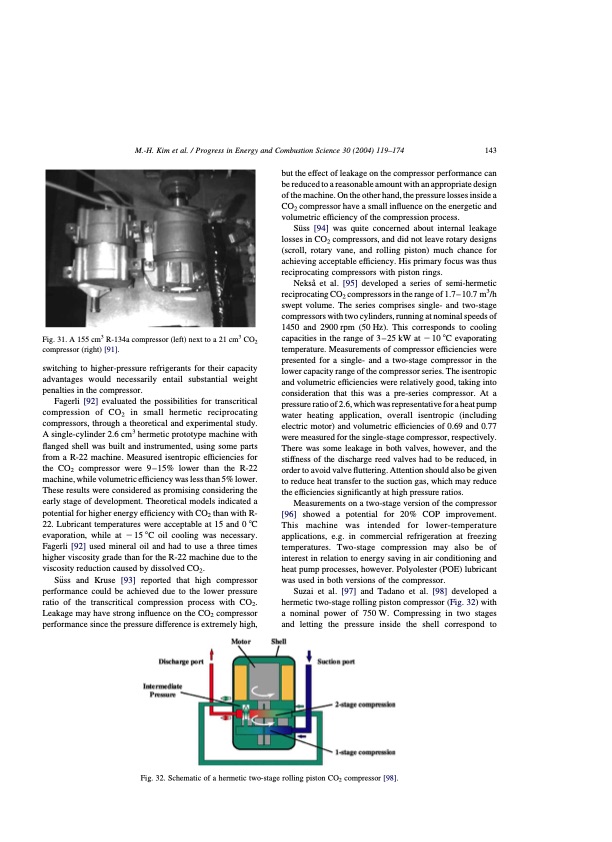
PDF Publication Title:
Text from PDF Page: 025
M.-H. Kim et al. / Progress in Energy and Combustion Science 30 (2004) 119–174 143 Fig. 31. A 155 cm3 R-134a compressor (left) next to a 21 cm3 CO2 compressor (right) [91]. switching to higher-pressure refrigerants for their capacity advantages would necessarily entail substantial weight penalties in the compressor. Fagerli [92] evaluated the possibilities for transcritical compression of CO2 in small hermetic reciprocating compressors, through a theoretical and experimental study. A single-cylinder 2.6 cm3 hermetic prototype machine with flanged shell was built and instrumented, using some parts from a R-22 machine. Measured isentropic efficiencies for the CO2 compressor were 9 – 15% lower than the R-22 machine, while volumetric efficiency was less than 5% lower. These results were considered as promising considering the early stage of development. Theoretical models indicated a potential for higher energy efficiency with CO2 than with R- 22. Lubricant temperatures were acceptable at 15 and 0 8C evaporation, while at 2 15 8C oil cooling was necessary. Fagerli [92] used mineral oil and had to use a three times higher viscosity grade than for the R-22 machine due to the viscosity reduction caused by dissolved CO2. Su ̈ss and Kruse [93] reported that high compressor performance could be achieved due to the lower pressure ratio of the transcritical compression process with CO2. Leakage may have strong influence on the CO2 compressor performance since the pressure difference is extremely high, but the effect of leakage on the compressor performance can be reduced to a reasonable amount with an appropriate design of the machine. On the other hand, the pressure losses inside a CO2 compressor have a small influence on the energetic and volumetric efficiency of the compression process. Su ̈ss [94] was quite concerned about internal leakage losses in CO2 compressors, and did not leave rotary designs (scroll, rotary vane, and rolling piston) much chance for achieving acceptable efficiency. His primary focus was thus reciprocating compressors with piston rings. Neksa ̊ et al. [95] developed a series of semi-hermetic reciprocating CO2 compressors in the range of 1.7 – 10.7 m3/h swept volume. The series comprises single- and two-stage compressors with two cylinders, running at nominal speeds of 1450 and 2900 rpm (50 Hz). This corresponds to cooling capacities in the range of 3–25 kW at 210 8C evaporating temperature. Measurements of compressor efficiencies were presented for a single- and a two-stage compressor in the lower capacity range of the compressor series. The isentropic and volumetric efficiencies were relatively good, taking into consideration that this was a pre-series compressor. At a pressure ratio of 2.6, which was representative for a heat pump water heating application, overall isentropic (including electric motor) and volumetric efficiencies of 0.69 and 0.77 were measured for the single-stage compressor, respectively. There was some leakage in both valves, however, and the stiffness of the discharge reed valves had to be reduced, in order to avoid valve fluttering. Attention should also be given to reduce heat transfer to the suction gas, which may reduce the efficiencies significantly at high pressure ratios. Measurements on a two-stage version of the compressor [96] showed a potential for 20% COP improvement. This machine was intended for lower-temperature applications, e.g. in commercial refrigeration at freezing temperatures. Two-stage compression may also be of interest in relation to energy saving in air conditioning and heat pump processes, however. Polyolester (POE) lubricant was used in both versions of the compressor. Suzai et al. [97] and Tadano et al. [98] developed a hermetic two-stage rolling piston compressor (Fig. 32) with a nominal power of 750 W. Compressing in two stages and letting the pressure inside the shell correspond to Fig. 32. Schematic of a hermetic two-stage rolling piston CO2 compressor [98].PDF Image | CO2 Vapor Compression Systems

PDF Search Title:
CO2 Vapor Compression SystemsOriginal File Name Searched:
co2-vapor-compression-systems.pdfDIY PDF Search: Google It | Yahoo | Bing
CO2 Organic Rankine Cycle Experimenter Platform The supercritical CO2 phase change system is both a heat pump and organic rankine cycle which can be used for those purposes and as a supercritical extractor for advanced subcritical and supercritical extraction technology. Uses include producing nanoparticles, precious metal CO2 extraction, lithium battery recycling, and other applications... More Info
Heat Pumps CO2 ORC Heat Pump System Platform More Info
| CONTACT TEL: 608-238-6001 Email: greg@infinityturbine.com | RSS | AMP |